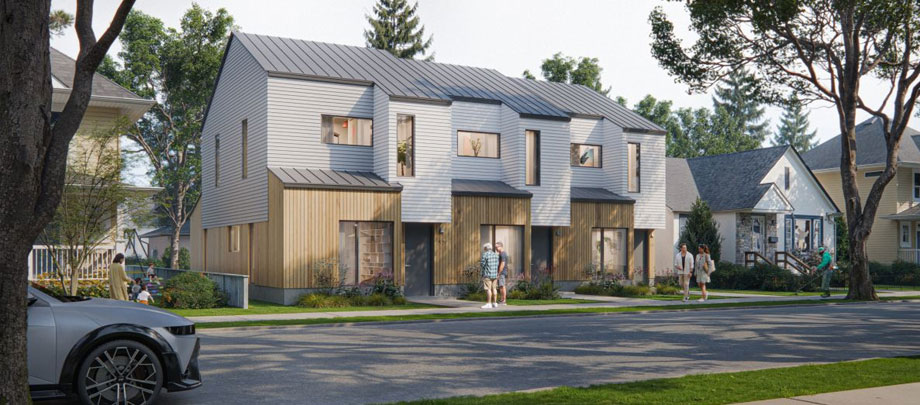
This report shares insights into the creation of “Missing Middle” housing options since 20181 in Canada’s 6 major cities2: Vancouver, Edmonton, Calgary, Toronto, Ottawa and Montréal. We do this using our housing starts3 data, which facilitates comparisons over time and across cities using a common definition.
Missing Middle housing is important as it provides a layer of supply that can be delivered within existing neighbourhoods. It can often be faster to develop — especially when rezoning isn’t needed — and requires less capital investment than larger projects. It broadens housing choices for families who can’t afford single-detached homes and find high-rise apartments do not offer enough space for their needs.
Stakeholders, particularly policymakers at the municipal government level, working to encourage this kind of development, can benefit from understanding its prevalence in their communities. They can also gain insights into what built form it takes, its location and the reasons behind regional differences.
What is the “Missing Middle”?
The "Missing Middle" is a broad term that refers to ground-oriented housing types typically characterized by gentle- to-medium-density. As no standard definition exists, in this report, the dwelling types of the Missing Middle4 include:
- accessory suites
- multiplexes
- row homes
- stacked townhouses
- low-rise apartments (4 storeys or less)
In some of Canada’s major cities, these kinds of developments, which could be more family-friendly, have long been underrepresented in new supply. That’s why they’re referred to as “Missing”.
We also included residential conversions. These include both residential to residential and non-residential to residential conversions. However, due to data limitations, they could not be broken down further by dwelling type. They comprise a category of their own in our analysis as they often create Missing Middle units through the adaptive reuse of existing buildings.
For detailed definitions of these dwelling types and more, please consult the glossary.
There’s been a steady increase in Missing Middle housing starts across Canada’s 6 major cities, but this masks significant regional differences
Missing Middle starts increased by an average of 5% annually between 2018 and 2023, followed by exceptionally strong growth of over 44% between 2023 and 2024 (Figure 1).
Prairie cities lead Missing Middle construction, Vancouver and Toronto lag
In 2024, Calgary and Edmonton initiated nearly 21,000 units, accounting for 67% of Missing Middle starts across the 6 centres (Figure 2). Both cities have seen rapid growth in recent years. Vancouver and Toronto, in contrast, accounted for the fewest such starts over much of our sample period.
Development in the Prairie cities has been supported by strong interprovincial population growth and rental demand, with a notable shift towards rental construction. Abundant land availability and a lower regulatory burden have supported the growth of Missing Middle housing. Favourable policies and incentives have further facilitated this development along with broader increases in overall housing starts.
In contrast, Missing Middle starts in Vancouver have declined sharply, falling 56% between 2018 and 2024. Industry sources indicate high land costs reduce the viability of smaller projects across much of the city but especially in and around the downtown core. Similar challenges are noted in Toronto. Both cities have since enacted measures to improve the economics of this kind of development. For example, Toronto recently waived development charges for projects with up to 6 units.
Ottawa and Montréal together accounted for 21% of Missing Middle construction in 2024. Following the 2022 interest rate hikes, these starts have helped cushion the downturn in overall development activity in these cities. Smaller projects may be more feasible in a challenging development climate. They require less capital and may, under certain circumstances, be easier to finance.5
Missing Middle development looks very different across the country
The type and location of Missing Middle housing construction vary widely across cities, influenced by factors such as land costs, developer expertise and evolving local policies.
Low-rise apartments feature prominently in Montréal and, to a lesser extent, Vancouver
Over our study period (2018 – 2025 Q2), apartment structures with 4 or fewer storeys have been the most built type of the Missing Middle in Montréal (Figure 3). These buildings have long been a part of the City’s urban landscape. This will likely continue to be the case following density directives in the recently adopted 2050 Land Use and Mobility Plan.
Low-rise apartments are commonly built in and around downtown Montréal neighbourhoods. This type of housing has flourished in these areas due to high density traffic, proximity to amenities and historically permissive zoning.
Small apartment buildings have also made up a sizeable, though smaller, share of Missing Middle development in Vancouver. Unlike Montréal, these buildings are more likely to be built outside the downtown core. High land costs in downtown Vancouver make taller buildings necessary to ensure financial viability. This pattern of development aligns with the goals outlined in the Vancouver Development Plan (PDF).
Accessory suites increasingly used as a tool to offset homeownership costs in Vancouver
In Vancouver, accessory suites are equally common as low-rise apartments. Previous analysis by CMHC (PDF) found that, over the past 2 decades, the City saw significant growth in the number of single-detached homes sold with accessory dwellings. These units are often rented out to help offset homeownership carrying costs.
Row homes are the dominant built form of Missing Middle housing in Ottawa
Row homes accounted for 61% of Missing Middle construction starts in Ottawa. Between 2018 and 2025 Q2, this marked the highest share for any single Missing Middle housing type across the 6 cities studied (Figure 3). This is due to several factors:
- Row homes have long been permitted by the zoning by-law and likely encounter fewer regulatory hurdles.
- The availability of greenfield land in the suburbs has been permissive of new subdivisions.
- Row homes are comparatively more affordable than detached homes for young households who are increasingly in search of family-oriented housing.
While much of this development is found in inner and outer suburbs, the City of Ottawa is drafting a new zoning by-law. The proposed changes aim to encourage higher density city-wide.
Calgary and Edmonton build many row subdivisions in the suburbs but have rapidly been infilling the core
For similar reasons to Ottawa, row homes have made up a significant part of Missing Middle starts in Calgary and Edmonton. This type of development is common in newer suburban communities, designated as Developing Areas in both the Calgary and Edmonton Land Use Plans.
However, there has been a concerted push by both cities, in recent years, to increase gentle density in established neighbourhoods. We observed this shift in the data where, since 2024, there has been a sharp increase in infill conversions, particularly in Calgary. Nevertheless, Missing Middle construction in the peripheries continues to lead.
Residential to residential infill conversions drive Missing Middle housing in Toronto
Since 2024, infill conversions have quickly become the leading way to deliver Missing Middle housing in Toronto. This growth aligns with recent city-wide zoning reforms allowing up to 4 units as-of-right6 and robust rental demand.
In Toronto, limited availability of undeveloped land makes gentle density through infill development a necessity. Notably, during the first half of 2025, there were over 4 times as many units initiated through conversion than there’ve been combined single- and semi-detached starts on new foundations.
Unlike high-rise construction, which is concentrated in the downtown core, infill conversions are happening across the city. These projects are adding density to neighbourhoods that were previously limited to single- and semi-detached homes (Figure 4). These conversions are also concentrated near major transit and amenities.
Figure 4: Conversions More Dispersed Than Mid- and High-Rise Apartment Construction Starts in Toronto
Neighbourhood’s Share of City of Toronto Starts, by Type (2024)
Apartment Starts (5+ Storeys)

Starts Initiated by Conversion

Note: Demarcated sub-regions are CMHC defined neighbourhoods. There was no starts activity in those with white fill.
Source: CMHC
Takeaways and implications
No universal definition of Missing Middle Housing — geographically and over time
The definition of Missing Middle housing varies by location and changes over time. This lack of consistency creates challenges in several areas:
- limitations in sharing best practices between cities
- engaging in national-level dialogue on interventions to increase this type of housing
- tracking the growth of Missing Middle housing
A shared and consistent definition of the Missing Middle would help cities learn from each other’s experiences and measure their own progress over time.
Bottlenecks to Missing Middle development differ by centre
In some areas, like Montréal, Missing Middle housing, as defined in this work, is already well-integrated into the City’s gentle densification policies and its traditional housing stock. Efforts to increase this type of housing would be able to use the presence of small developers with an existing interest in building low-rise apartments.
By contrast, in Toronto, where developers have traditionally been larger and more focused on high-rise construction, the historical capacity for Missing Middle housing development has been lower. Industry sources suggest larger players are hesitant to invest in multiple smaller projects due to unique challenges such as:
- navigating varied zoning and site-specific requirements
- long approval processes
- fewer cost savings compared to larger projects
A more supportive regulatory environment for Missing Middle development
Missing Middle housing has the potential to add more housing options in existing neighbourhoods and increase the diversity of housing supply. The notable increase in Missing Middle starts in 2024 and early 2025 suggests a shift in the regulatory environment. This shift has been driven by initiatives such as recently adopted as-of-right zoning permissions in major cities.7 Building permit data may be a leading indicator of future Missing Middle starts and conversions.
As local markets adapt to new zoning permissions, we expect to see a higher volume of Missing Middle starts. This is likely to include more multiplex starts relative to the historical focus on accessory dwelling units. It is also expected to lead to a greater volume of conversions resulting in multiplexes and low-rise apartments.
Opportunities for further analysis
This report represents another important step for CMHC toward gaining a deeper understanding of Missing Middle development in Canada. There are further opportunities for analysis, including:
- evaluating the feasibility of Missing Middle development
- assessing its affordability and suitability
- exploring more detailed neighbourhood-level development patterns
Glossary
Footnotes
Sign up to get regular updates on Canada’s housing industry sent to your inbox.






 Share via Email
Share via Email
